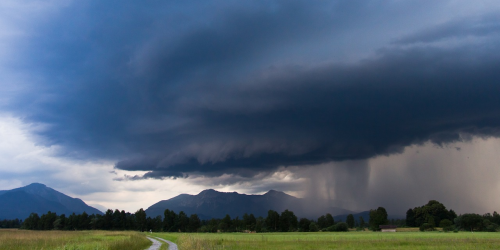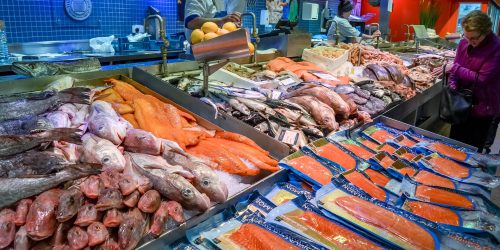CPO’s Climate Variability and Predictability (CVP) Program is announcing eight new three-year projects in Fiscal Year 2022 (FY22) that aim to build upon and refine the current scientific understanding of the equatorial Pacific climate system. The tropical Pacific region is important to climate variability due to its role in El Niño-Southern Oscillation (ENSO) and the teleconnections to the United States’s weather and climate. Outcomes from the selected projects will be used to further the development of a possible field campaign(s) in this region. The competitively selected 8 projects total $5.57 million1, including $4.33 million in grants and $1.24 million in other awards.


In order to improve understanding of the climate system and its representation in models we need high-quality, consistent, long-term observations of the many parameters of the climate system. The fundamental overarching goal of the Tropical Pacific Observing System (TPOS) effort is to enhance and redesign international observations of the tropical Pacific. In the First Report of TPOS 2020, many recommendations and proposed actions were identified. The use of process studies that will inform further refinement of TPOS, as well as model improvements, was noted as a critical part of the implementation process that can guide the development of the system design. Two of the studies that are recommended in the report are called Pacific Upwelling and Mixing Physics (PUMP) and Air–sea Interaction at the eastern edge of the Warm Pool (EEWP).
In Fiscal Year 2022, the CVP program solicited observationally-based and/or modeling projects that will build upon and refine the current scientific understanding of the equatorial Pacific climate system with a specific focus on two process studies identified in the TPOS 2020 First Report:
- Pacific Upwelling and Mixing Physics (PUMP) – These studies expect to increase information for upwelling/mixing physics and parameterization schemes in ocean circulation and climate models, and to determine the minimum sustained observations needed to quantify the Pacific upwelling and monitor changes over time.
- Air–sea Interaction at the eastern edge of the Warm Pool (EEWP) – These studies expect to understand the air-sea interaction processes and the role of upper ocean salinity stratification in maintaining the warm sea surface temperatures (SSTs) at the eastern edge of the west Pacific warm pool, in particular focusing on the air-sea coupling on intraseasonal timescales.
Both studies will focus on improved predictability of the overall evolution of the Pacific climate system on seasonal to interannual timescales (MJO, ENSO, etc.), which is beneficial to NOAA’s mission of improved environmental prediction. Outcomes from the selected projects will be used to further the development of a possible field campaign(s) in this region.
The 8 new projects funded by the CVP Program in FY22 are:
- Developing a framework for a field campaign in the cold tongue: Analysis of Pacific Upwelling and Mixing Physics from models and observations
The Equatorial Pacific Cold Tongue (EPCT) is an area in the eastern Pacific Ocean characterized by cold sea-surface temperatures (SST). These are mainly due to upwelling, a process in which deep, cold water rises toward the surface. The EPCT is of high importance (and a key region for Tropical Pacific Observing System process studies) as it supports exchanges of heat and other biogeochemical properties between the atmosphere and the ocean. This project will investigate the mixing and upwelling processes in the EPCT by analyzing observations and output from four high-resolution ocean models including Parallel Ocean Program 2 (POP2), Tropical Pacific Ocean State Estimation 3 (TPOSE.3), the regional Massachusetts Institute of Technology General Circulation Model (MITgcm), and Large Eddy Simulations (LES).- PI: Anna-Lena Deppenmeier, University Corporation for Atmospheric Research
- Co-PI(s): Deepak A. Cherian, Frank O. Bryan, University Corporation for Atmospheric Research; LuAnne Thompson, University of Washington, William S. Kessler, NOAA/PMEL. Collaborators: Daniel B. Whitt, NASA-AMES; Ryan M. Holmes, University of Sydney.
- EquatorMix Remix: Assimilation of a Process Study Campaign for Estimating Pacific Upwelling and Mixing Physics
The Equatorial Undercurrent (EUC) in the tropical Pacific Ocean brings cold waters near the surface, where mixing happens. Besides upwelling, there are other water transport processes that occur, which are important to ocean, weather and climate forecasts.also need to be modeled and understood. This project will use data from the 2012 EquatorMix study to examine mixing processes and larger scale forcing of upwelling in the Tropical Pacific Ocean. The new Tropical Pacific Ocean State Estimate 24 (TPOSE.24) will be applied to diagnose the mechanisms controlling mixing and to understand the sources of error due to unresolved or poorly modeled processes.- PI: Matthew Mazloff, University of California – San Diego
- Co-PI(s): Bruce Cornuelle, Ariane Verdy, University of California – San Diego
- Exploiting coupled ocean-atmosphere-wave model simulations to identify observational requirements for air-sea interaction studies across the tropical Pacific
The current Tropical Pacific Observing System (TPOS) is insufficient to characterize the transient and fine-scale nature of the ocean-atmosphere-wave interactions (exchanges of energy, momentum, and gases). This shortcoming affects the ability to fully understand the impacts of these interactions on regional drivers of climate variability patterns. This project will use a high-resolution coupled model (SCOAR) framework to identify key gaps in the understanding of ocean-atmosphere-wave interactions in the Tropical Pacific. It will also explore how these might be targeted in future observations.- PI: Hyodae Seo, Woods Hole Oceanographic Institution
- Co-PI(s): Susan Wijffels, Woods Hole Oceanographic Institution
- Optimizing coupled boundary layer process studies in the tropical Pacific using high resolution models and in situ observations
The West Pacific Warm Pool is an area of persistent warm water in the tropical West Pacific region. Its Eastern Edge (EEWP) is an area where cooler waters from the east meet the warm water of the west. This area can greatly influence the subseasonal and interannual weather and climate patterns. This study examines the observed tropical ocean, layers in the upper ocean that can act as barriers, and how models reproduce the ocean-atmosphere connections. This is important because forecasts of global climate patterns (e.g., Madden-Julian Oscillation and El Niño-Southern Oscillation) can be improved by better modeling of this region. This project will identify and study key processes to determine the need for increased observations to help reduce systematic errors in modeling the coupled ocean-atmosphere boundary layer. The project will use existing observations and reanalyses, output from numerical models including Coupled Model Intercomparison Project 6 (CMIP6), European Centre for Medium-Range Weather Forecasts (ECMWF), and Observing System Simulation Experiments (OSSEs) to fulfill the objective.- PI: Aneesh Subramanian, University of Colorado at Boulder
- Co-PI(s): Kris Karnauskas, University of Colorado at Boulder, Charlotte DeMott, Colorado State University; Janet Sprintall, University of California – San Diego.
- Collaborators: Ho-Hsuan Wei, University of Colorado at Boulder; Magdalena Balmaseda, ECMWF.
- Uncrewed Surface Vehicles as a Research Platform for Tropical Pacific Observing Platform (TPOS) Field Campaigns
The First Report of TPOS recommended addressing uncertainties in processes regulating sea surface temperatures (SSTs) in the tropical Pacific Ocean. These uncertainties often lead to biases in the eastern tropical Pacific and reduced skill in El Niño Southern Oscillation (ENSO) predictions. New Uncrewed Surface Vehicles (USVs) offer great promise to study upwelling events in the Pacific (PUMP) and for new observations of phenomena like the Eastern Edge of the Warm Pool (EEWP), which can migrate zonally tens of thousands of kilometers. This project will use recent USV observations and model output to test the capabilities of these platforms in a virtual setting. It will also make recommendations on the minimum number of vehicles needed to perform EEWP and PUMP studies.- PI: Yolande Serra, University of Washington
- Co-PI(s): Samantha Wills, University of Washington. Collaborators: Meghan Cronin, NOAA/Pacific Marine Environmental Laboratory – PMEL; Dongxiao Zhang, University of Washington/CICOES
- Observing the Air-Sea Transition Zone Using Combined Uncrewed Systems: Feasibility and Requirement
Air-sea interaction plays a critical role in regional and global weather and climate patterns. This exchange of energy between the atmosphere and ocean happens in the Air-Sea Transition Zone (ASTZ), an area where properties from both come together. Recent developments in uncrewed systems may provide an alternative to ships and aircraft to observe the ASTZ. This project will virtually deploy in a modeling framework Combined Uncrewed Systems (CUSs) including underwater gliders, saildrones, and aerial drones to assess their feasibility and usefulness in measuring the characteristics of the ASTZ in the West Pacific Warm Pool.- PI: Chidong Zhang, NOAA/Pacific Marine Environmental Laboratory – PMEL
- Co-PI(s): Shuyi Chen, University of Washington, Patricia Quinn (NOAA/PMEL).
- Collaborator: William Kessler, NOAA/PMEL
- Understanding Equatorial Pacific Climate Processes via Hierarchical Coupled Modeling
Coupled general circulation models (CGCMs) are mathematical models that simulate the Earth’s climate system. Even though CGCMs are widely used in climate forecasting, these models exhibit errors and biases over the Equatorial Pacific Cold Tongue (EPCT), a key region for TPOS studies. Constraining these errors is difficult due to a lack of detailed observations in the region, which affect model simulation of EPCT physical processes such as air-sea interactions, upwelling, and mixing. This project will use a hierarchy of NOAA’s Geophysical Fluid Dynamics Laboratory (GFDL) CGCMs simulations to identify links among emergent biases and processes in the EPCT. Looking towards a future field campaign, the results will ultimately refine observing strategies to improve model simulations and reanalyses, and climate outlooks.- PI: Andrew T. Wittenberg, NOAA/Geophysical Fluid Dynamics Laboratory – GFDL
- Co-PI(s): Brandon Reichl, Fanrong Zeng (NOAA/GFDL), Feiyu Lu, Alistair Adcroft (Princeton/AOS/CIMES)
- Coupling of the Tropical Air-sea Boundary Layers: Resolving Key Processes Using Observations and Multi-scale Coupled Modeling and Analysis
Given its importance for developing accurate predictions of tropical atmosphere-ocean interactions, processes in the atmospheric and oceanic boundary layer need to be more fully understood. This project aims to use the sensitivity of coupled models to changes in boundary layer resolution and parameterizations as a tool to develop a field measurement strategy for the eastern edge of the warm pool (EEWP) in the tropical Pacific Ocean. The analysis will include existing datasets from the Salinity Processes in the Upper-Ocean Regional Study 2 (SPURS-2) and the Dynamics of the Madden-Julian Oscillation (DYNAMO) campaigns, as well as numerical modeling (WRF-ROMS). The study will ultimately provide insight into the resolution and type of instrument array needed for various measurement platforms in the ocean and atmosphere.- PI: Carol Anne Clayson, Woods Hole Oceanographic Institution
- Co-PI(s): James Edson, Woods Hole Oceanographic Institution; Eric Skyllingstad, Oregon State University
1The funding will be distributed over the life of the projects and future-year funding is conditional on appropriations.
2 At the time of publication, all awards may not have been accepted by recipient institutions





